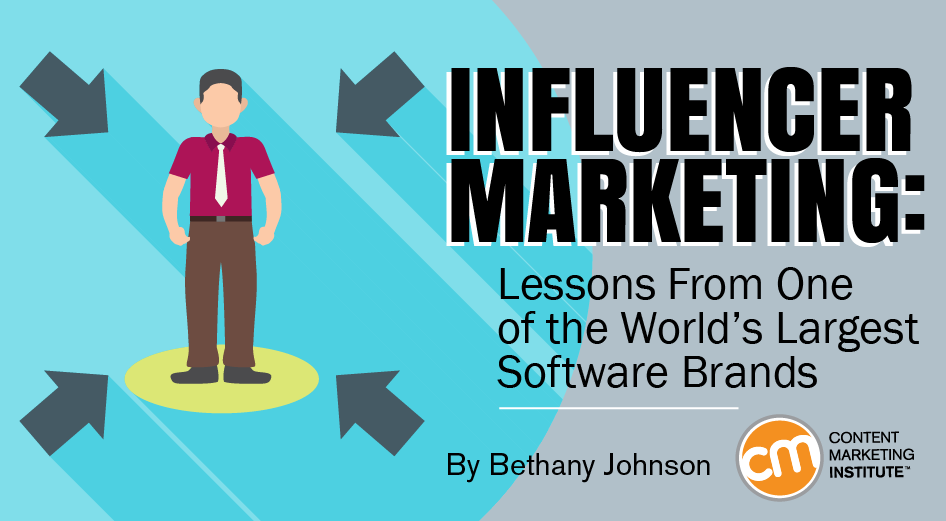Author: Bethany Johnson / Source: Content Marketing Institute

You’re the largest enterprise application software company in the world. You have 88,000 employees and nearly 400,000 customers. Your revenue last year was a smart $29.4 billion. Industry influencers are lining up, knocking on your door for an opportunity to collaborate. Right?
Well, no.
Even successful, established brands must start at the ground floor to build a B2B influencer marketing program – the same as an agile, scrappy startup.
Amisha Gandhi, VP, influencer marketing, SAP Ariba, says that, just as in one’s personal life, worthwhile relationships take more than numbers-flexing on either side.
In her 2017 Content Marketing World talk, Creating a Global Influencer Marketing Program at a Large B2B Brand, Amisha shares what she learned about using proactive, reciprocal actions to build successful relationships between SAP and industry personalities.
She offers the lessons learned along the way to help B2B brands create influencer marketing programs:
- Set a clear goal.
- Choose the right influencers to meet that goal.
- Keep influencer relationships warm and give as much as you get.
- Equip internal teams and influencers with tools to help programs succeed.
Let’s dive deeper into Amisha’s explanation for each directive.
Set a clear goal
Amisha started SAP’s program with, as she put it, “a blank slate.” No centralized, global influencer marketing existed at SAP before late 2015. Rather than create a worldwide program all at once, Amisha planned a phased rollout that would result in learning she could build on for future programs.
For the pilot project, she set her sights on SAP Sapphire 2016, an annual event that attracts 20,000 CIOs and IT professionals and was mere months away. She needed to create an influencer program that complemented the existing marketing campaign and set goals she could meet in the short timeline.
She sought to secure IT influencers to:
Given her team’s responsibility for lead and demand generation, she knew basic awareness was not sufficient. “Our goal was to drive awareness and demand gen,” Amisha says. “We really want to take people from top to middle funnel.”

That clarity of purpose helped the team zero in on everything from selecting the right set of influencers to how to use the materials created.
Choose the right influencers to meet your goal
While B2C influencers tend to be celebrities, B2B influencers should be people your potential buyers trust for advice. Even then, it makes sense to understand the varying approaches, offerings, and sway of different kinds of B2B influencers.
Amisha drew from SiriusDecisions’ influencer framework to reflect on the possibilities, and she advises marketers to consider the output they want the influencers to produce to help narrow the list:
- Authors and academics tend to produce books, keynote presentations, educational materials, popular blogs, videos, etc.
- Industry analysts, commentators, consultants, and partners are known for in-depth research, speeches, reports, thought-provoking conversations (or predictions), and an active social presence.
- Vocal bloggers, journalists, and subject matter experts crank out articles, books, and guest contributions for popular industry publications.
- Online communities, professional groups, and industry forums produce events, publications, and industry standards.
- Executives, chief evangelists, and product managers are great for co-producing white papers, books, and dynamic speeches.
- Employees, vendors, users, and partners can be tapped for influential case studies, video testimonials, and social sharing.
- Business colleagues and professional acquaintances influence their circles with water-cooler conversations, emails, and social media.
Decide: Influencer relations or influencer marketing?
One distinction Amisha calls out between influencer relations and influencer marketing can help you focus your options:
Influencer relations involves top-of-funnel awareness-building (such as events and coverage). At most companies, that’s covered by PR and analyst relations teams who work to earn coverage from journalists, bloggers, and top-tier analyst firms.
Influencer marketing serves a deeper part of the funnel. Independent analysts, consultants, and other tech experts whom the desired audience and potential buyers already rely on for purchasing guidance make sense here, as do partners and customers.
Once she knew what kind of influencers to invite (tech experts, independent analysts, etc.), outreach began. A lot of people believe SAP’s…
Audience Team
The digital audience insights you need to build, manage and market to your digital audiences.

